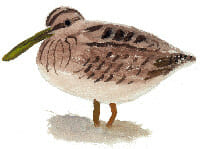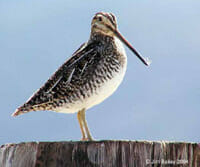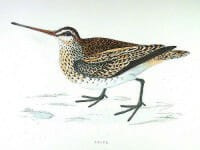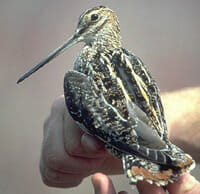Snipe – Charadriiformes Scolopacidae Gallinago gallinago
 |
 |
 |
 |
Identification & Description:
• Stocky, short-legged, pointed-winged shorebird
• Explosive takeoff when flushed, rapid zigzag flight
• Very long, straight bill
• Legs olive
• Head patterned with alternating dark and pale stripes
• Pale breast with darker spots and bars
• Strongly patterned back with several buffy, longitudinal stripes
• Rusty brown rump and tail visible in flight
• White belly, dark bars on flanks
• Upperwings dark, secondaries with white tips
• Found primarily in marshes and wet fields
• Sexes similar
• Juvenile similar to adult
• Length: 9 inches
Similar species:
American Woodcock has a plain, buffy breast, rounded wings and a distinctive head pattern. Dowitchers are similar in size and shape but lack prominent crown and back stripes, and have a white rump and barred tail.
Snipes make up the genera Gallinago, Lymnocryptes, and Coenocorypha of the family Scolopacidae. The common snipe is classified as Gallinago gallinago.
Snipe, common name for shorebirds of three genera of the sandpiper family. Snipes breed abundantly on all continents except Australia (where, however, one species winters). Snipes have long, slender bills, sensitive at the tip, which are used to probe for worms and grubs in swampy grasslands. They are highly regarded as game birds because of their twisting, erratic flight after they are flushed.
A typical species is the common snipe of Eurasia and North America, where it was long known as Wilson’s snipe. It is mottled and striped with brown, black, and buff and is about 28 cm (about 11 in) in length. In courtship the male performs acrobatic revolutions in flight and drops suddenly from a height, producing a drumming beat as the air rushes past the quills in its tail.